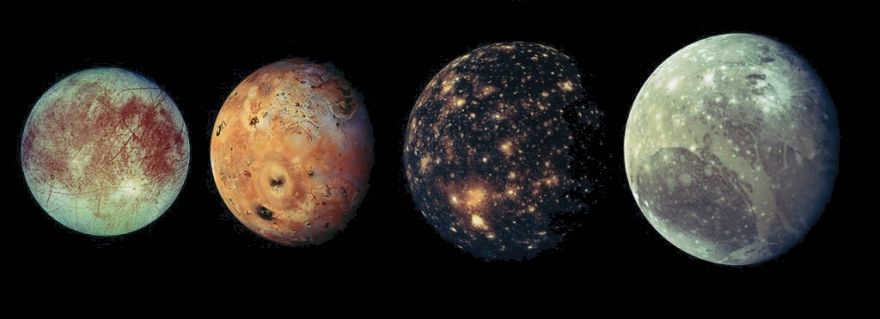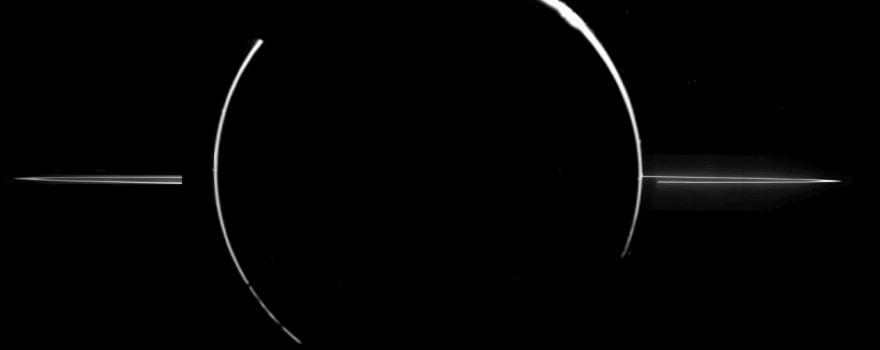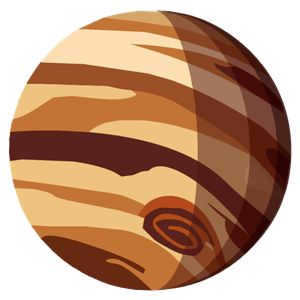
Discover interesting facts and information about the planet Jupiter for kids, including photos and pictures. Jupiter is the largest planet in our solar system and it is fifth in distance from the Sun. It is named after the king of all the gods in Roman mythology, and the Greeks called it Zeus, their supreme deity.
Parents and teachers can explain to children that Jupiter is the largest planet in our solar system and it is located fifth from the Sun. It is named after the king of all the gods in Roman mythology. Similarly, the Greeks called it Zeus, their supreme deity.
It can be confidently stated that 1610 marked a significant milestone in our understanding of the Universe and our position within it. At that time, Galileo made a groundbreaking discovery by identifying four large satellites orbiting Jupiter: Io, Europa, Ganymede, and Callisto. These celestial bodies are now commonly referred to as Galileo’s moons. This momentous achievement represented the first instance of observing objects in orbit around another celestial body, with the notable exception of our own Earth. This finding provided further support for Copernicus’ revolutionary notion that the Earth does not occupy the central position in the solar system.
On this page, you will find a comprehensive overview of Jupiter, complete with captivating visuals, diagrams, and a side-by-side comparison with Earth. It’s crucial for students and individuals of all ages to grasp the concept that no other planet within our solar system surpasses the sheer magnitude of Jupiter. While it is true that Saturn and Uranus are sizable in their own right, they pale in comparison to this gas giant. Jupiter is often likened to a failed (or nearly) star, making the comparison to the Sun all the more significant.
Explanation of the Physical Characteristics of Jupiter for Children
It is crucial to help children understand just how immense Jupiter is. If we were to combine all the planets in our solar system and mold them into a single colossal sphere, Jupiter would still be twice its size. Fascinatingly, if Jupiter were 80 times larger, it would actually undergo the process of “star formation”. Similar to the Sun, Jupiter possesses a comparable atmosphere composed of hydrogen and helium. Additionally, in addition to its four major moons, Jupiter boasts a vast number of smaller moons orbiting around it, resembling a miniature solar system. To provide a comprehensive explanation to children, it’s worth mentioning that there are approximately 1,300 planets similar to Earth within Jupiter.
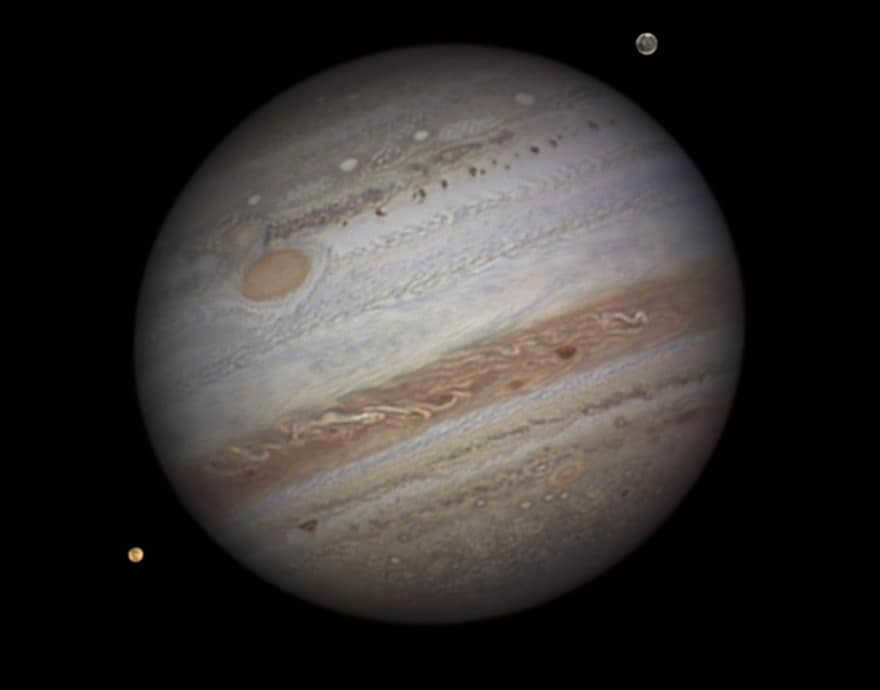
A unique photo of Jupiter was taken on September 20, 2010, when it made its closest approach to Earth since 1963.
Jupiter is known for its incredibly strong magnetic field, which is about 20,000 times stronger than Earth’s. This magnetic field creates an intense electron belt and traps charged particles, affecting the planet’s moons and rings. The radiation levels in this region are 1000 times higher than what is considered lethal for humans, making Jupiter a dangerous place even for heavily shielded spacecraft like NASA’s Galileo probe. Jupiter’s magnetosphere extends in the opposite direction of the Sun for 1-3 million kilometers, tapering off into a tail that can stretch 1 billion kilometers behind the planet.
The planet also boasts the highest rotational velocity, completing one full revolution on its axis in just over 10 hours. As a result, Jupiter undergoes significant flattening at its poles and expansion at its equator, with the latter experiencing a 7% increase in size.
Furthermore, Jupiter emits powerful radio waves that can be detected from Earth. These waves can be categorized into two types: intense bursts, which occur when Io or another large moon traverses certain regions of its magnetic field, and continuous radiation originating from the planet’s surface and the energetic particles present in its radiation belts. Scientists utilize these waves to study Jupiter’s moons and their potential oceans.
The focus is mainly on the Great Red Spot, an enormous storm that has been continuously raging for over three hundred years. It may come as a surprise to children, but this storm is actually three times larger than the Earth’s diameter and its outer edge rotates counterclockwise at a speed of 360 km/h. The color of the storm varies from a deep red to a pale brown, possibly due to the presence of sulfur and phosphorus deposits within ammonia crystals in the planet’s clouds. The size of the spot fluctuates, sometimes even seeming to vanish entirely.
The Structure and Composition of Jupiter – An Explanation for Kids
- What is Jupiter made of? Jupiter’s atmosphere is mostly made up of molecular hydrogen (89.8%) and helium (10.2%). There are also small amounts of other substances like ammonia, ethane, methane, hydrogen dehydride, water, ammonium hydrosulfide aerosols, ammonia ice aerosols, and water ice aerosols.
- Jupiter’s Magnetic Field: Did you know that Jupiter’s magnetic field is almost 20,000 times stronger than Earth’s?
- What is Jupiter’s composition like? Inside Jupiter, there is a dense core whose composition is not yet determined. This core is surrounded by a ball of liquid metallic hydrogen, which is rich in helium. And all of this is wrapped in an atmosphere made of molecular hydrogen.
- What is Jupiter’s internal structure? Jupiter has a core that is about 10 times the mass of Earth. Surrounding this core is a ball of liquid metallic hydrogen, which makes up about 80-90% of the planet’s diameter. And all of this is set in an atmosphere composed of gaseous and liquid hydrogen.
- The average distance from the Sun is 778,412,020 km, which is 5.203 times the distance of Earth.
- Perihelion, the closest distance to the Sun, is 740,742,600 km, which is 5.036 times the distance of Earth.
- Aphelion, the greatest distance from the Sun, is 816,081,400 km, which is 5.366 times the distance of Earth.
Explanation of Jupiter’s Satellites for Kids
Parents should educate their children about Jupiter’s numerous satellites, which are named after beloved Roman gods. We previously mentioned the most significant ones, known as the Galilean moons, which were discovered by Galileo Galilei.
Ganymede, the largest satellite in the entire solar system, is even larger than Mercury, Pluto, and surprisingly, even bigger than Earth’s moon. In addition, Ganymede is the only moon known to possess its own magnetic field. It is believed that beneath its icy surface, there may be at least one ocean.
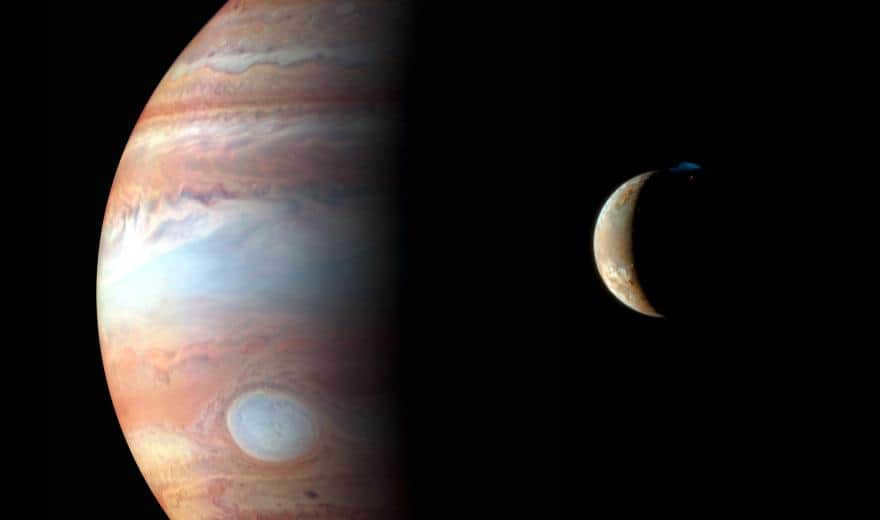
Jupiter and its satellite Io with active volcanoes.
Io is known for its high volcanic activity, making it the satellite with the most active volcanoes. The moon has a distinct yellow-orange appearance due to the sulfur it emits. The gravitational pull of Jupiter causes tides on Io’s solid surface, with some areas being raised up to 100 meters. This tidal heating is responsible for triggering the volcanic eruptions on the moon.
Europe, another one of Jupiter’s moons, has a frozen crust primarily composed of water ice. Scientists suspect that beneath this icy surface lies a hidden liquid ocean. If confirmed, this ocean would contain twice as much water as Earth. Similar icy oceans may also exist beneath the crusts of Callisto and Ganymede, Jupiter’s other moons. Recent observations have revealed new spots at the south pole of these moons, suggesting the presence of these hidden oceans. The potential for finding life in these oceans has led NASA to seek funding for new missions to explore these moons further.
Out of the four, Callisto exhibits the lowest amount of light. As a result, the surface of the moon appears devoid of color and consists of dark, rocky terrain.
An Explanation of Jupiter’s Rings for Kids
In 1979, Voyager 1 made a remarkable discovery when it found three rings encircling Jupiter’s equator. Although not as prominent as Saturn’s rings, each ring was still quite faint.
The primary ring, known as the main ring, is relatively flat and measures 30 kilometers in thickness and 6,400 kilometers in width.
The innermost ring, called the halo, is reminiscent of a cloud and can be as thick as 20,000 kilometers. The halo is positioned between the main ring and the top of Jupiter’s cloud cover and gradually expands, blending in with the planet’s magnetic field. Both the main ring and the halo consist of dark particles.
The disturbances seen in the bands of Jupiter and Saturn may suggest the possibility of collisions with comets or asteroids.
Exploring Jupiter and its Missions – a Kids’ Guide
Fun Fact:
Did you know that there have been a total of 7 missions to Jupiter? These include Pioneer 10 and 11, Voyager 1 and 2, Ulysses, Cassini, and New Horizons. Additionally, NASA’s Galileo spacecraft even orbited the planet!
Pioneer 10 illustrated the hazards of the radiation belt, while Pioneer 11 provided data on the Great Red Spot and captured detailed images of the polar region. Voyager 1 and 2 played a crucial role in creating the initial comprehensive maps of the Galilean satellites, uncovering rings, sulfur volcanoes on Io, and lightning in the planet’s clouds. Ulysses revealed that the solar wind has a much greater impact on the planet’s magnetosphere than previously believed. New Horizons captured high-resolution photographs of Jupiter and its largest satellites.
In 1995, Galileo dispatched a probe to the planet, conducting the first-ever measurements of the atmosphere, including the amount of water and other chemicals present. When it depleted its fuel, the spacecraft intentionally crashed into the atmosphere to avoid contaminating Europa with Earth’s microorganisms.
In 2016, the Juno spacecraft embarked on a mission to explore the polar orbit of Jupiter. Scientists are currently in the process of analyzing the data obtained from this mission. Unsurprisingly, these studies have provided a comprehensive understanding of the planet, which has in turn led to the creation of a detailed map of Jupiter, depicting its various moving zones and belts.
Explaining the Gravitational Influence of Jupiter on the Solar System to Children
It is crucial to explain to children that Jupiter is the most massive celestial body in our solar system, and its gravitational force has played a significant role in shaping our system. According to reports, Jupiter’s gravity pushed out Neptune and Uranus, and together with Saturn, it propelled debris towards the inner planets, enabling their formation. Additionally, Jupiter acts as a shield for Earth, protecting it from asteroids and preventing potentially catastrophic collisions.
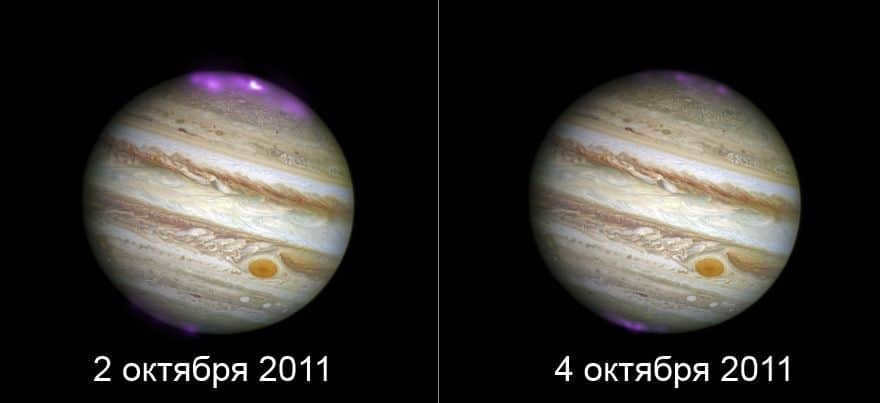
The phenomenon of polar auroras can be observed on the gas giant Jupiter.
Currently, the gravitational force of Jupiter acts as a protective barrier against Trojan asteroids, which are named after characters from Homer’s Iliad, such as Agamemnon, Achilles, and Hector.
Explaining the Possibility of Life on Jupiter to Children
Imagine if someone could dive into Jupiter’s atmosphere. As they descend, they would feel the temperature rise, getting warmer and warmer with each depth. Eventually, they would reach a level where the temperature is just like a comfortable room (21°C). At this altitude, the atmospheric pressure is ten times greater than that on Earth. Scientists think that this might be a place where life could exist, but they haven’t found any concrete evidence yet. However, there is still hope that life could be discovered on Jupiter’s moons.
We trust you had a great time exploring the narrative regarding Jupiter, the largest celestial body in our Solar System and a colossal gas giant. Our website offers an awe-inspiring 3D model of the solar system, giving you an up-close view of Jupiter’s distinctive surface features. This captivating visual format is sure to captivate the curiosity of children. Additionally, we have an extensive collection of spacecraft photographs, stunning art depictions, and immersive videos. If you’re feeling adventurous, you can even utilize our online telescope to observe Jupiter in real-time, completely free of charge. Prepare to be amazed by a plethora of intriguing facts that await you, so don’t ever give up on your personal exploration.
RELATED ARTICLE:
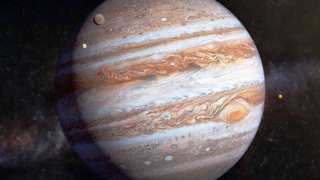
When it comes to describing this giant gas planet, the superlative degree is frequently utilized. The reason for this is that Jupiter is not only the largest entity in the entirety of the solar system, but it is also the most enigmatic. It also holds the first position in terms of mass, rotational velocity, and second in terms of brightness. Even if you were to combine all of the planets, moons, asteroids, and comets in the solar system, Jupiter would still surpass them all in size. It is mysterious due to the fact that the constituent elements of this entity are found within the matter that makes up the entire solar system. Additionally, everything that occurs on the surface and within the depths of this colossal planet can be viewed as a representation of the synthesis of materials that takes place during the formation of planets and galaxies.
If Jupiter were to be even more massive and larger, it could potentially be classified as a “brown dwarf”.
This massive entity serves as a genuine guardian of our planet: its immense gravitational force attracts and captures any incoming comets.
Discovery Background
Jupiter is ranked as the second brightest celestial body after Venus. As a result, it, along with the other four planets, can be observed directly from Earth’s surface without the need for any optical equipment. This explains why its discovery cannot be credited to any specific scientist, as it likely belongs to the earliest civilizations.
However, the first scientist to engage in systematic observations of this colossal planet was the Italian astronomer Galileo Galilei. In 1610, he made the groundbreaking discovery of the first four satellites orbiting Jupiter, which he named Ganymede, Io, Europa, and Callisto. This significant finding marked a historic milestone in the field of astronomy and these satellites have since become known as the Galilean moons.
The revelation provided assurance to scientists who identified as heliocentrists, and empowered them to confront proponents of alternative theories with renewed vigor. As optical devices advanced, researchers were able to accurately measure the dimensions of the celestial body and subsequently uncovered the Great Red Spot, which was initially believed to be a landmass within Jupiter’s vast ocean.
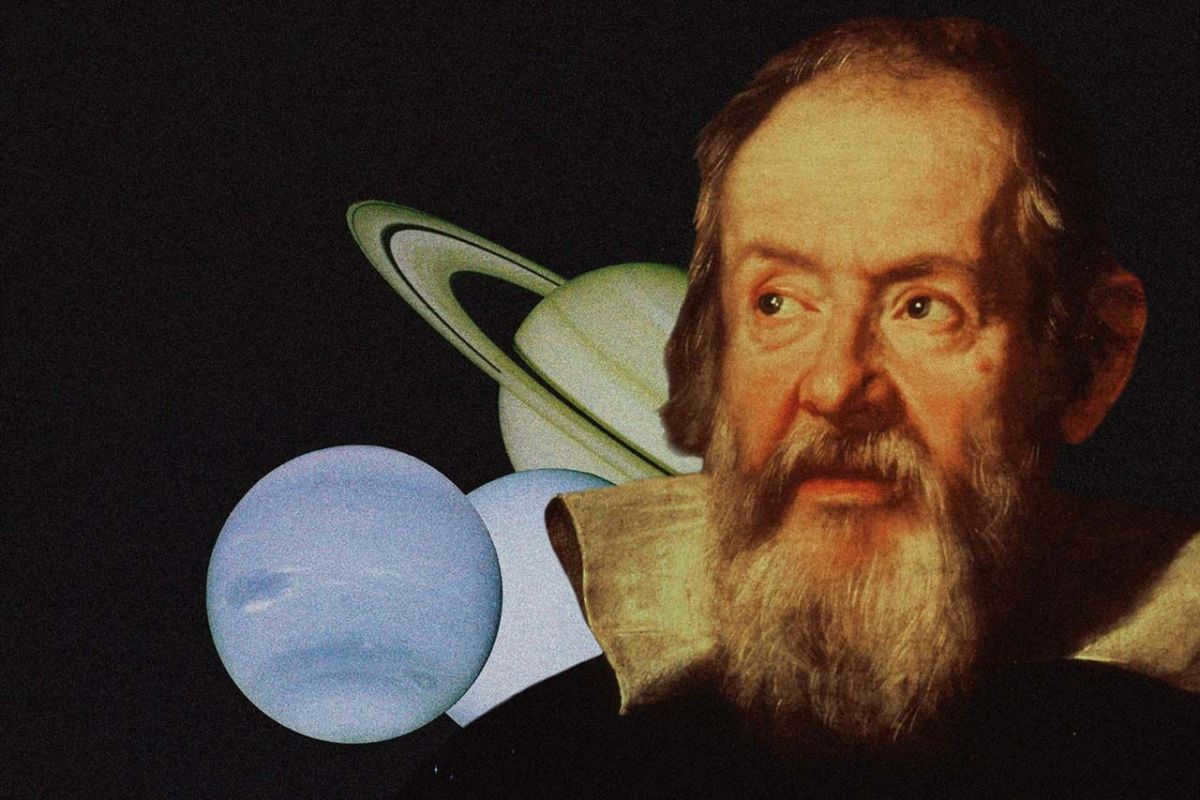
Exploration
In the years 1972-1974, the planet Jupiter was visited by two Pioneer spacecraft. During their mission, they were able to observe various aspects of the planet, including its asteroid belt, radiation levels, and its powerful magnetic field. These observations led scientists to speculate that there may be a liquid substance inside Jupiter capable of conducting electricity. Additionally, the second Pioneer spacecraft provided evidence suggesting that Jupiter may have rings.
In 1977, the Voyager spacecraft were launched and reached Jupiter just two years later. They captured and transmitted back to Earth the first breathtaking images of the planet, confirming the existence of its rings. Furthermore, these images allowed scientists to understand that the atmospheric processes occurring on Jupiter are much more intense and spectacular than those on Earth.
Due to its intense radiation emission, the gas giant is so hazardous that spacecraft are reluctant to approach it closely for fear of damaging their on-board electronics.
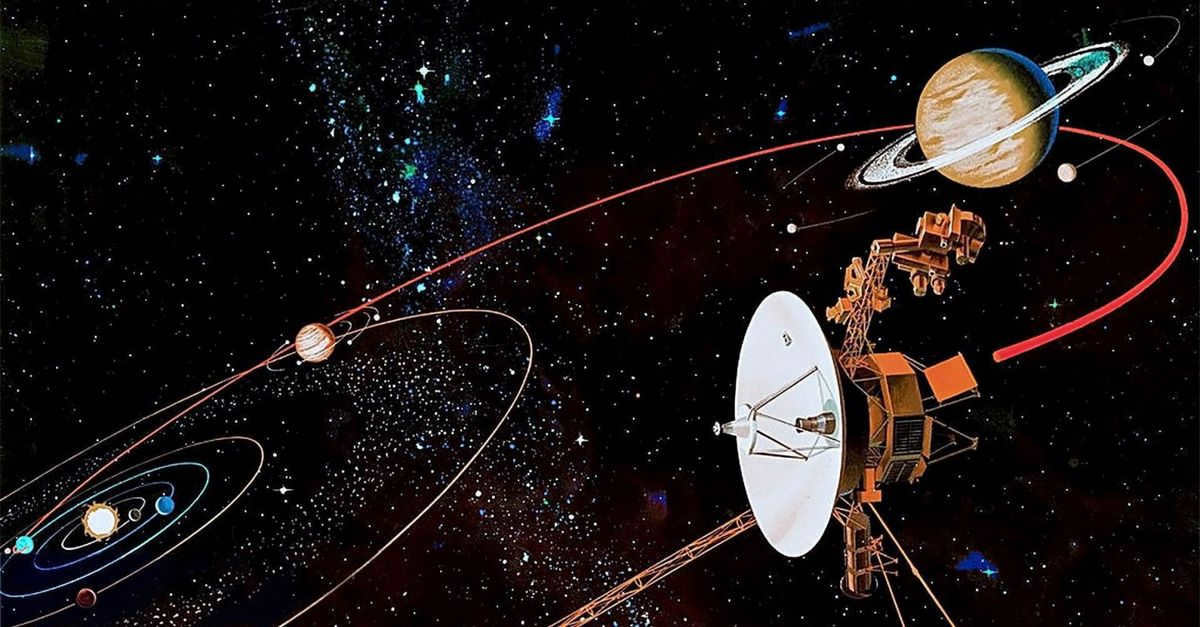
Distinctive Features
Jupiter possesses the subsequent physical attributes:
- Equatorial radius – 71,492 kilometers (with an error margin of 4 kilometers).
- Polar radius – 66,854 kilometers (with an error margin of 10 kilometers).
- Surface area – 6.21796⋅1010 square kilometers.
- Mass – 1.8986⋅1027 kilograms.
- Volume – 1.43128⋅1015 cubic kilometers.
- Rotational period – 9.925 hours.
- Presence of rings
Jupiter, with its strongest magnetic field, is the largest, fastest, and most treacherous object in our solar system. It boasts the largest number of known satellites and is believed by scientists to have captured and preserved interstellar gas from the cloud that birthed our Sun.
However, despite these impressive attributes, Jupiter falls short of being a star. In order to achieve star status, it would need to possess more mass and heat, which are necessary for the fusion of hydrogen atoms and the formation of helium. According to experts, Jupiter would need to increase its mass by about 80 times to initiate thermonuclear fusion. Nevertheless, Jupiter currently emits some heat due to the compression of gravity, which reduces its volume but raises its temperature.
Movement
Jupiter possesses not only an immense size but also an atmosphere. Its composition consists of 90 percent hydrogen and 10 percent helium. As a gas giant, the atmosphere and the rest of the planet are not distinct. As it descends towards the core, the temperature and density of hydrogen and helium undergo changes. This results in the division of Jupiter’s atmosphere into four regions:
Since Jupiter lacks a solid surface, scientists define the lower boundary of its atmosphere at the point where the pressure reaches one bar. As one moves higher in altitude, the temperature of the atmosphere decreases, reaching a minimum point. The troposphere and stratosphere of Jupiter are separated by the tropopause, which is situated approximately 50 kilometers above the planet’s “surface”.
Within the expanse of the enormous planet, there exists a minute concentration of methane, ammonia, water, and hydrogen sulfide in its atmosphere. These particular substances are accountable for the creation of remarkably picturesque clouds, which can be observed from Earth’s surface through telescopes. The precise hue of Jupiter cannot be definitively determined. Nevertheless, from an artistic standpoint, it can be described as having a red-white appearance with alternating light and dark bands.
The observable parallel bands on Jupiter are actually composed of ammonia clouds. The dark bands are referred to as the poles by scientists, while the light bands are known as the zones. These bands alternate with one another, with the dark bands being solely comprised of ammonia. However, the specific substance or compound responsible for the lighter tone has yet to be identified.
Jupiter is home to the most magnificent storm in the entire Universe – the Great Red Spot. This awe-inspiring tempest has been raging for hundreds of Earth years without any signs of stopping. With winds reaching an astonishing speed of 432 kilometers per hour, it is truly a force to be reckoned with. In fact, the storm is so massive that it could easily contain three Earths within its colossal borders.

Satellites of Jupiter
Jupiter’s largest satellites, which were first discovered by Galileo in 1610, marked a significant milestone in the field of astronomy. These satellites, including Ganymede, Io, Europa, and Callisto, have been extensively studied. In addition to these well-known satellites, there are other bodies that have attracted scientific attention, such as Phoebe, Amalthea, Jupiter’s Rings, Himalia, Lysithea, and Metida. These celestial bodies formed from the gas and dust that surrounded Jupiter after its formation. It took many years for scientists to identify the remaining satellites of Jupiter, and to date, there have been sixty-seven confirmed satellites. This number is unparalleled by any other planet, and it is possible that there are even more satellites yet to be discovered.
Ganymede, the largest moon of Jupiter, is also the largest moon in our entire solar system. If it orbited the Sun instead of Jupiter, scientists would categorize it as a planet. With a diameter of 5,268 kilometers, Ganymede is 2 percent larger than Titan and 8 percent larger than Mercury. Positioned just over a million kilometers from the surface of Jupiter, Ganymede is the only moon in the solar system that possesses its own magnetosphere.
Ganymede’s surface is composed of 60 percent unexplored ice bands and 40 percent ancient ice “shell” or crust, which is adorned with countless craters. The ice bands are estimated to be 3.5 billion years old, having formed through geological processes that are currently under scrutiny.
The primary component of Ganymede’s atmosphere is oxygen, giving it a similar composition to Europa’s atmosphere. The craters observed on the satellite’s surface appear to be relatively flat, lacking a central depression. This is attributed to the ongoing movement of Ganymede’s soft icy surface.
Jupiter’s moon Io exhibits volcanic activity, with mountains on its surface reaching heights of up to 16 kilometers.
Scientists speculate that beneath Europa’s icy surface layer, there exists a liquid ocean.
Jupiter’s Rings
The rings of Jupiter were created from particles of dust, which is why they are incredibly difficult to distinguish. Scientists believe that these rings were formed when the planet’s moons collided with comets and asteroids, causing material to be ejected into space. Eventually, Jupiter’s powerful gravity captured this material, resulting in the formation of its rings. The ring system is composed of four distinct components:
- Thor or Halo (a thick ring)
- The main ring (a thin ring)
- Spider Ring 1 (a transparent ring made of Thebes material)
- Spider Ring 2 (a transparent ring made of Amalthea material)
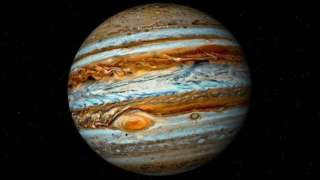
The largest planet in the solar system is called “Jupiter”. This celestial body has been known to humanity since ancient times and continues to captivate our interest. Currently, extensive research is being conducted on Jupiter, its moons, and the various phenomena associated with it. This exploration is ongoing and shows no signs of slowing down in the future.
Etymology
The moniker “Jupiter” was derived from the ancient Roman pantheon’s deity of the same title. In Roman mythology, Jupiter was revered as the supreme god, the sovereign of the heavens and the entire universe. Alongside his siblings Pluto and Neptune, he constituted the league of paramount gods, who wielded unparalleled might. The archetype of Jupiter can be traced back to Zeus – the principal deity amongst the Olympian gods in the ancient Greek faith.
Names in various cultures
In ancient times, the Romans were not the only ones who knew about the planet Jupiter. The people of the Babylonian kingdom, for instance, associated it with their supreme god, Marduk, and referred to it as “Mulu Babbar,” meaning “white star.” The Greeks, as we know, connected Jupiter with Zeus, and in Greece, the planet was known as “Zeus’s star.” Chinese astronomers called it “Sui Xing,” which translates to “Star of the Year.”
Interestingly, indigenous tribes in India also made observations of Jupiter. The Incas, for example, called this giant planet “Pirwa,” which meant “warehouse” or “barn” in the Quechua language. It is possible that this choice of name was influenced by the Indians’ observation of not only the planet itself but also some of its satellites.
Jupiter, the fifth planet from the Sun, is located between Saturn and Mars in our solar system. It is classified as a gas giant, distinguishing it from the rocky terrestrial planets. Being primarily composed of gaseous elements, Jupiter has a low density and a rapid daily rotation.
The immense size of Jupiter sets it apart as a true giant. With an equatorial radius measuring 71,400 kilometers, it is 11 times larger than Earth. Additionally, Jupiter boasts a staggering mass of 1.8986 x 1027 kilograms, surpassing the combined mass of all the other planets.
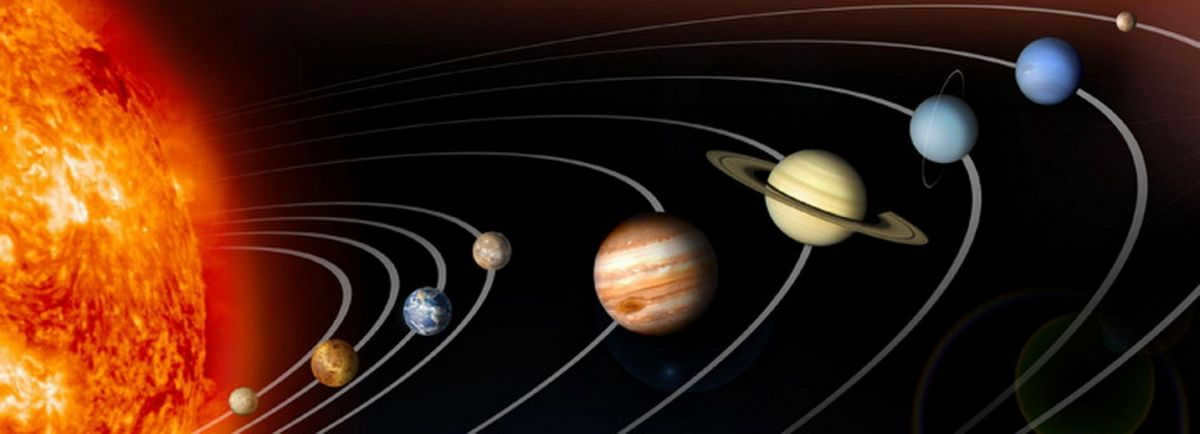

Composition
There are various theories regarding the composition of Jupiter, but the most widely accepted model consists of three layers:
- Atmosphere: Comprising of three layers, namely the outer layer of hydrogen, the intermediate hydrogen-helium layer, and the lower layer of hydrogen-helium mixed with other elements. Interestingly, beneath Jupiter’s opaque cloud layer lies the hydrogen layer, which transitions from a gaseous state to a liquid state. This transition occurs as the pressure and temperature increase. The boundary between the gas and liquid phases is not clearly defined, giving rise to a constant “boiling” effect in the hydrogen ocean.
- A layer of metallic hydrogen with an approximate thickness ranging from 26 to 42 thousand kilometers is present. Metallic hydrogen is a substance that forms under high pressure (around 1,000,000 At) and high temperature.
- The core of the planet has an estimated size that is 1.5 times the diameter of the Earth and a mass that is 10 times the mass of Earth. The core’s mass and size can be determined by studying the planet’s inertial moments.
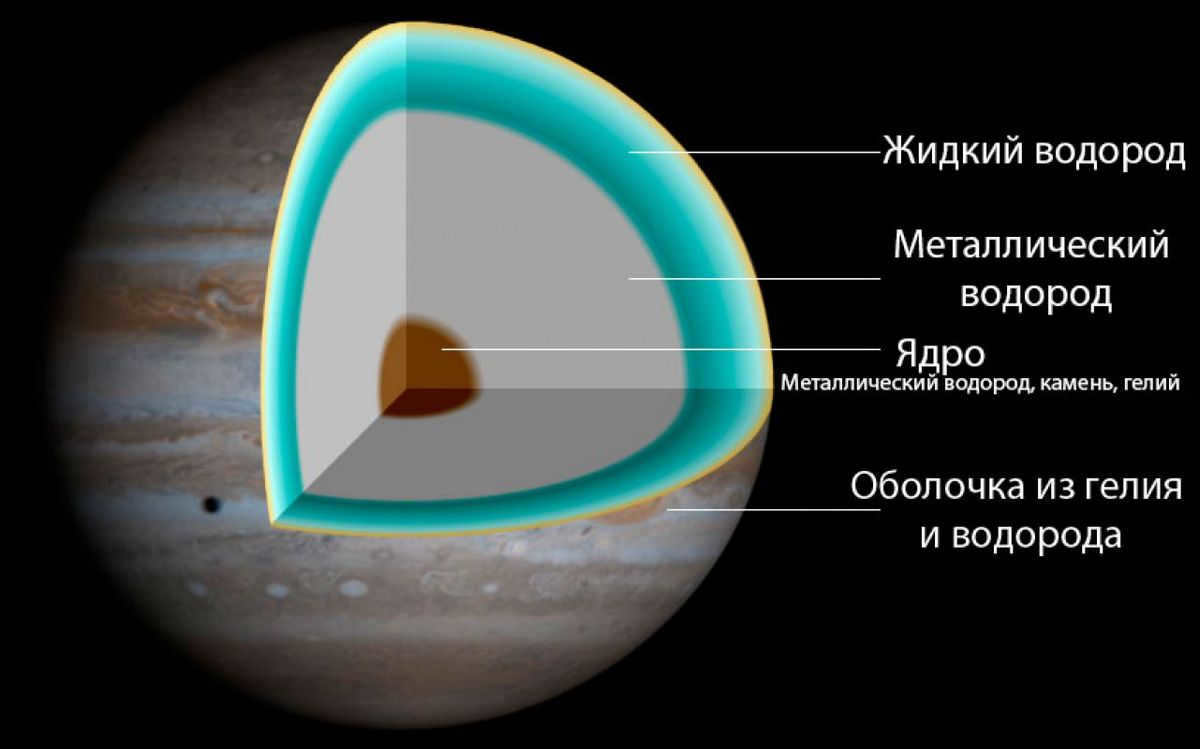

The Rings of Jupiter
While Saturn is well-known for its rings, it is not the only planet in the solar system with this feature. Rings have also been discovered around Uranus and Jupiter. Jupiter’s rings can be categorized as follows:
- Main Ring: This ring has a width of 6,500 kilometers and a radius ranging from 122,500 to 129,000 km. Its thickness varies from 30 to 300 km.
- Spiderwebs Rings: These rings consist of the Amalthea ring, which has a width of 53,000 km, and the Thebes ring, which has a width of 97,000 km. The radius of the Amalthea ring ranges from 129,000 to 182,000 km, while the radius of the Thebes ring ranges from 129,000 to 226,000 km. The thickness of the Amalthea ring is approximately 2000 km, while the thickness of the Thebes ring is approximately 8400 km.
- Halo Ring: This ring has a width of 30,500 km and a radius ranging from 92,000 to 122,500 km. Its thickness is approximately 12,500 km.
The idea of Jupiter having rings was initially proposed by Soviet astronomers, but it was confirmed by the Voyager 1 space probe in 1979.
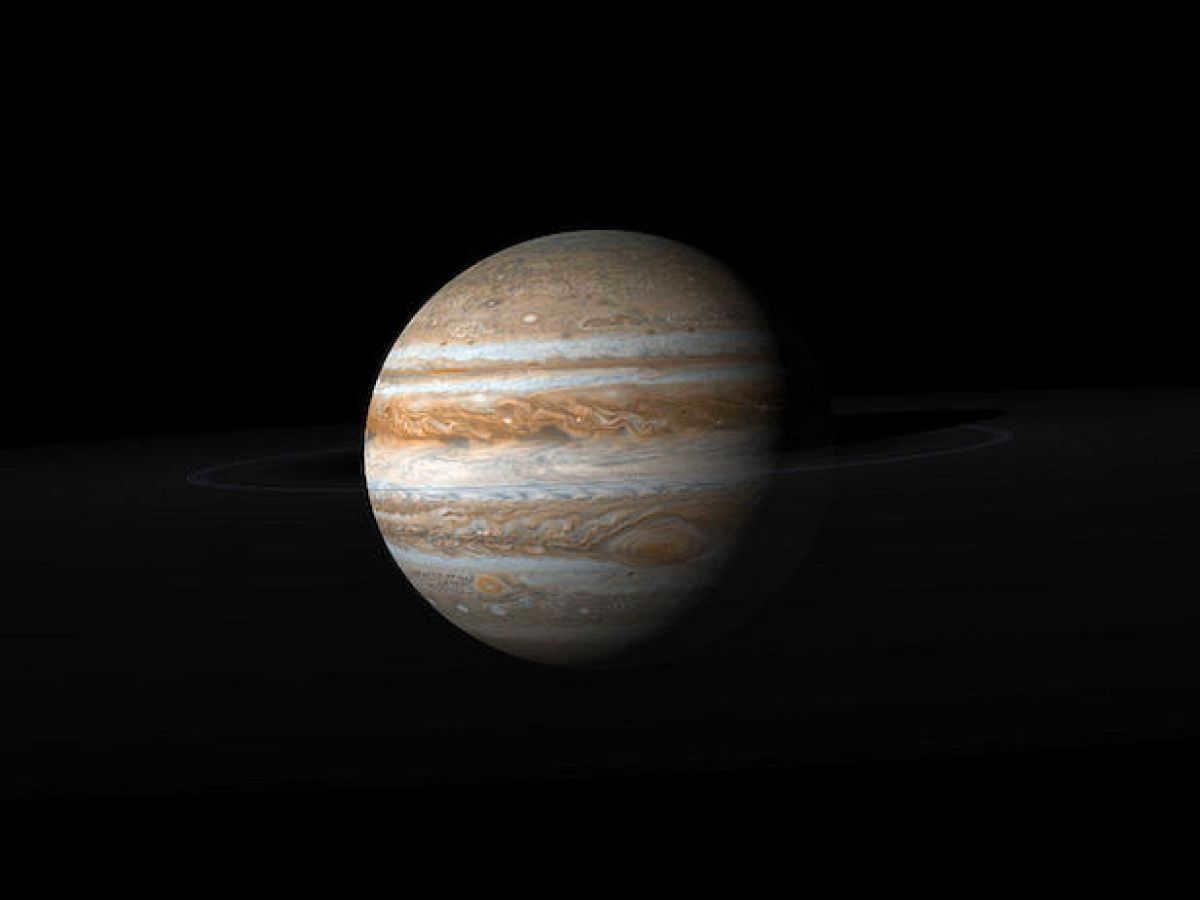
History of the Genesis and Development
In the present era, scientific research presents two conjectures concerning the genesis and development of the gaseous colossal celestial body.
Contraction Hypothesis
The underpinning of this supposition is predicated upon the resemblance in chemical composition between Jupiter and the Sun. The fundamental aspect of this theory postulates that during the nascent stages of the solar system, substantial coalescences materialized within the protoplanetary disk, which subsequently transformed into the Sun and the celestial orbs.
Accretion hypothesis
The central idea of the hypothesis is that the creation of Jupiter took place in two distinct phases. In the initial phase, rocky planets akin to Earth were formed. In the subsequent phase, there was a process of gas accretion, whereby these celestial bodies attracted gas and transformed into the gas giants Jupiter and Saturn.
A concise history of research
It is evident that the ancient civilizations were the first to observe Jupiter, but it was not until the 17th century that more systematic investigations of the colossal planet began. This marked the time when Galileo Galilei developed his revolutionary telescope and embarked on the study of Jupiter, during which he made the groundbreaking discovery of its four largest moons.
Following Galileo, Giovanni Cassini, a notable French-Italian engineer and astronomer, made significant observations of Jupiter, particularly noting the presence of streaks and spots on its surface.
During the same century, Ole Rømer conducted a comprehensive study on the eclipses of Jupiter’s moons, which enabled him to accurately determine the positions of these satellites and, ultimately, calculate the speed of light.
Subsequently, the rise of advanced telescopes and spacecraft sparked a surge in the investigation of Jupiter. Leading the charge was the National Aeronautics and Space Administration (NASA) of the United States, which launched a myriad of space stations, probes, and other vehicles. Each of these missions yielded crucial data that facilitated the exploration of the phenomena unfolding on Jupiter and its moons, shedding light on the underlying mechanisms at play.
Some facts about Jupiter’s satellites
Currently, there are 63 known satellites of Jupiter, which is the highest number among all planets in the solar system. Out of these, 55 are classified as external satellites while the remaining 8 are considered internal satellites. However, scientists believe that the actual total number of satellites orbiting this gas giant could be more than a hundred.
Among the most prominent and well-known satellites are the ones known as the “Galilean” satellites. These were first discovered by the famous astronomer Galileo Galilei and include Ganymede, Callisto, Io, and Europa.
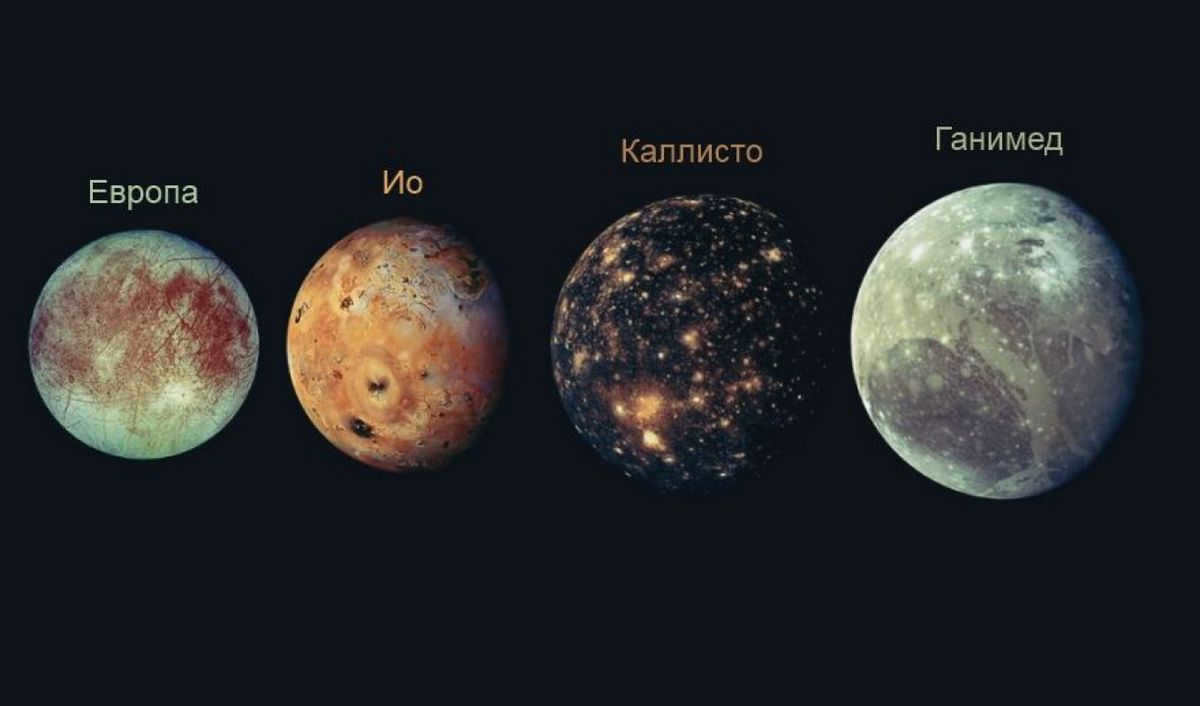
The Enigma of Existence
In the closing years of the 20th century, American astrophysicists dared to entertain the notion that life might possibly exist on the distant gas giant, Jupiter. Their hypothesis revolved around the potential role of ammonia and water vapor, both of which are known to be present in Jupiter’s atmospheric composition.
Yet, it would be premature to engage in earnest discussions regarding the plausibility of life on this colossal planet. The gaseous nature of Jupiter, coupled with its meager water content and a plethora of other factors, render such conjectures entirely baseless.
Did you know?
- Jupiter is the second brightest object in the sky, after the Moon and Venus.
- If you weigh 100 kilograms on Earth, you would weigh 250 kilograms on Jupiter due to its strong gravitational pull.
- During ancient times, alchemists associated Jupiter with the element tin.
- In astrology, Jupiter is considered the ruler of all the other planets.
- Jupiter completes one rotation in just ten hours.
- It takes Jupiter twelve years to complete one orbit around the Sun.
- Many of Jupiter’s moons are named after the mistresses of the god Jupiter.
- The volume of Jupiter is so large that it could fit over a thousand Earth-sized planets inside it.
- Unlike Earth, Jupiter does not have distinct seasons.
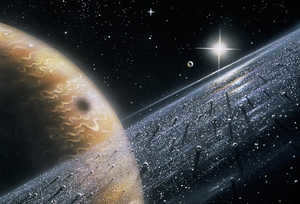
With the advent of space travel, the exploration of distant planets has become a reality and no longer surprises anyone. Scientists now have the opportunity to conduct in-depth studies of the planets, getting progressively closer to them. There are a total of eight planets in our solar system, and among them, Jupiter stands out as the largest, often referred to as the “gas giant”. This massive celestial body, easily visible to the naked eye, has captivated astronomers throughout history.
The arrangement of our solar system
The Sun is the most massive entity within our solar system. This colossal star is situated at the heart of a vast array of satellites. The spherical planets are illuminated by the radiant beams of the Sun and are positioned in the following order:
Based on their physical attributes, the planets can be categorized into two distinct groups, separated by the asteroid belt. The planets closest to the Sun – Mercury, Venus, Earth, Mars – are part of the terrestrial group (inner planets). These planets are relatively small in size and possess a density five times greater than that of water. They share a similar composition, consisting of a core, mantle, crust, and lithosphere composed of silicon and metals. Earth happens to be the largest planet among the inner group.
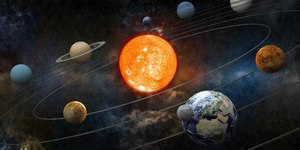
Jupiter, Saturn, Uranus, and Neptune are part of the outer group, which is the second group of planets. These celestial giants are the largest in size among all the planets in our solar system. In fact, they are much more massive and bulkier than the planets in the inner group, such as Earth. The reason for their larger size is their low average density, which means they are composed of lighter substances compared to the planets in the inner group. Specifically, these substances include hydrogen, ammonia, methane, and helium. It’s worth noting that these massive objects shine brightly in the night sky and have been observed by humans for centuries. However, the most distant ones were only discovered after the invention of telescopes. Additionally, it’s interesting to know that all planets, including Jupiter, Saturn, Uranus, and Neptune, orbit the Sun in the same direction and rotate on their own axes at different speeds within their respective orbits.
Previously, astronomers considered Pluto to be a planet, but recent spectroscopy studies have revealed its similarities to satellites. There is a possibility that it was once a satellite of Neptune and gradually drifted away from it. Starting from August 2006, Pluto has been classified as one of the icy objects in the Kuiper Belt, which is comprised of frozen methane and nitrogen and is situated on the outer edges of the solar system.
After determining the largest and most significant planets in the solar system, it is important to acknowledge the presence of numerous dwarf planets, comets, meteoroids of various sizes, and cosmic dust in the interplanetary space.
Gas giants
Gas giants are massive planets primarily composed of hydrogen and helium. They are also known as “failed stars” because they have a similar composition to stars but did not have enough mass to ignite nuclear fusion in their cores. Gas giants are characterized by their large size, low density, and lack of a solid surface. They are typically found in the outer regions of planetary systems and can have a variety of atmospheric conditions, including powerful storms and intense heat. Despite their name, gas giants are not entirely made up of gas; they also have solid cores surrounded by layers of gas. Some of the most well-known gas giants in our solar system include Jupiter and Saturn.
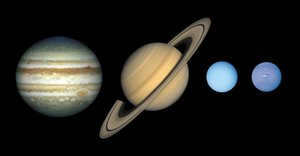
The inquiry regarding which planet stands as the largest within our solar system must be directed towards the gas giants. Jupiter, Saturn, Uranus, Neptune – these colossal planets possess unrivaled enigma and uniqueness. Numerous phenomena occurring within and on the surface of these celestial bodies still elude explanation. Their chemical composition greatly differs from that of the planets in close proximity to the Sun.
Objects within the outer reaches of space exist at significant distances from the Sun, experiencing low temperatures and renowned for their fierce cold winds and cyclones. Every member of the outer group possesses a ring system and satellites. Saturn, in particular, is renowned for its awe-inspiring rings.
Astronomers classify Uranus and Neptune as “ice giants” due to their frigid surface temperatures of -224°C. Neptune, the farthest planet from the Sun, was actually discovered through mathematical calculations.
The ruler of the planets
The question that lingers is: what is the moniker of the largest celestial body in our solar system? Well, it is none other than Jupiter – an awe-inspiring spectacle with its swirling clouds, the mesmerizing Great Red Spot, delicate rings, and a plethora of satellites both big and small. This beloved object of space exploration has been bestowed its name in honor of the Roman god of thunder. Here are a few fascinating tidbits about this celestial entity:
Key Facts
Without a doubt, Jupiter is the largest celestial body within our solar system, boasting a diameter that is a staggering 11 times that of Earth. The planet’s mesmerizingly vibrant and diverse atmosphere, replete with a myriad of multicolored clouds that stretch across its expanse, as well as the iconic Great Red Spot, lend Jupiter an unmistakable and picturesque appearance. The pioneering Pioneer 10 probe, launched in 1973, was able to capture the first-ever color images of this awe-inspiring gas giant. Subsequently, the Voyager spacecraft (1977) and the Hubble Space Telescope (1991) have also provided invaluable video footage, shedding further light on the violent and tumultuous meteorological phenomena that take place on Jupiter.
The rapid rotation of Jupiter creates powerful vortices that sweep across the upper atmosphere at speeds exceeding 500 kilometers per hour. These vortices stretch out the clouds and give rise to distinctive white and brown streaks. Massive hurricanes, spanning thousands of kilometers, can form and dissipate in a matter of days.
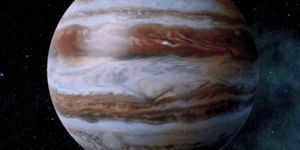
The Great Red Spot, a massive storm that has been raging for 300 years, continues to captivate astronomers. This storm, which is larger than the Earth itself, can be observed through a telescope. It was first discovered in 1663 and has been a subject of fascination ever since. However, recent observations have revealed that the Red Spot is slowly shrinking, raising questions about its future.
Jupiter, the planet where the Great Red Spot resides, is a fascinating celestial body. Unlike Earth, Jupiter does not have a clear boundary between its surface and atmosphere. Instead, the pressure levels gradually change as you descend into the planet. At a depth of 100 km, hydrogen undergoes a dramatic transformation from a gas to a liquid state due to the immense pressure. As you go even deeper, at around 17,000 kilometers, hydrogen takes on metallic properties and becomes a conductor of electricity. This forms a powerful magnetosphere around Jupiter, which generates a wide range of radio emissions.
The Earth is impacted by powerful and disorderly radio waves. The aurora borealis can be witnessed at the North and South Poles, as it is created by the magnetic field. The immense magnetic field of the giant, which captures charged particles, forms a radiation belt that surpasses the size of Earth’s.
Satellites orbiting the enormous Jupiter
Jupiter boasts an impressive number of satellites, with a total of 67. Back in 1610, Galileo, without the aid of powerful telescopes, managed to discover four major moons orbiting Jupiter: Ganymede, Io, Callisto, and Europa. These moons are commonly referred to as the Jupiterian moons. Thanks to modern space exploration, many smaller satellites orbiting this gas giant have been discovered over time.
Ganymede holds the title for being the largest satellite. In fact, it is even bigger than the planet Mercury and possesses its own magnetosphere. Io, on the other hand, is a satellite renowned for its intense volcanic activity. Its distinctive yellow-orange hue is due to sulfur emissions. Interestingly, Io experiences solid surface tides caused by the strong gravitational pull of Jupiter. Europa’s surface is primarily composed of water ice. Lastly, Callisto exhibits high reflectivity, suggesting a rocky surface.
There is still much to learn about gas giants, and numerous theories need to be verified and improved upon. The genesis and development of Jupiter continue to baffle scientists, as do the factors that prevented it from becoming a star. It appears that astronomers will have a wealth of new findings to uncover in the coming years.
Originally published on 2018-05-01 08:16:26.
Jupiter is the fifth celestial body from the Sun and is the most massive in our Solar System. It has a mass that is twice as large as the combined mass of all the other planets in our solar system. Jupiter belongs to the category of gas giants, along with Saturn, Uranus, and Neptune.
Humans have been aware of this planet since ancient times, and it has influenced the mythology and religious beliefs of various cultures.
Jupiter is primarily made up of hydrogen and helium, with a probable rocky core of heavier elements under extreme pressure at its center. Due to its fast rotation, the planet takes on a flattened spheroid shape, displaying a significant bulge around its equator. The outer atmosphere of Jupiter is clearly divided into elongated bands at various latitudes, resulting in storms and tempests where these bands intersect. One notable feature is the Great Red Spot, a massive storm that has been observed since the 17th century. According to data from the Galileo lander, the pressure and temperature increase rapidly as one descends deeper into Jupiter’s atmosphere. Additionally, Jupiter boasts a powerful magnetosphere.
Jupiter’s satellite system is composed of at least 63 satellites, which includes 4 large satellites known as the “Galilean satellites” that were initially discovered by Galileo Galilei in 1610. Ganymede, one of Jupiter’s satellites, has a larger diameter than Mercury. Europa, another one of Jupiter’s satellites, has been found to have a global ocean beneath its surface, while Io is renowned for possessing the most powerful volcanoes in the entire solar system. Additionally, Jupiter also possesses faint planetary rings.
Over the years, Jupiter has been extensively explored by a total of eight interplanetary stations launched by NASA. Notably, the Pioneer and Voyager spacecrafts were among the most significant explorations, followed by the Galileo spacecraft, which even released a probe into Jupiter’s atmosphere. The most recent spacecraft to visit Jupiter was the New Horizons probe, initially headed for Pluto.
Observation
When Jupiter is viewed from Earth during its opposition, it can appear as bright as -2.94 in apparent magnitude, making it the third most luminous object in the night sky, surpassed only by the Moon and Venus. However, its apparent magnitude can drop to -1.6 at other times.
When observing Jupiter using an 80-millimeter telescope, various details can be discerned, such as dark and light spots, as well as protrusions and depressions along the edges of its bands. If a telescope with an aperture of 150 mm or larger is used, the Great Red Spot and additional details within Jupiter’s belts can be observed. The Lesser Red Spot becomes visible when using a telescope with a 250 mm aperture and a CCD camera. Jupiter completes one full rotation in approximately 9 hours and 55 minutes, allowing observers to view the entire planet over the course of a single night.
Jupiter’s oppositions from 1951 to 2070.
Physical attributes
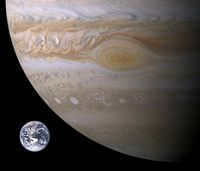
Orbital characteristics
Jupiter is unique among the planets in that its center of mass is located outside the Sun and is approximately 7% of the solar radius away from it. The average distance between Jupiter and the Sun is 778 million kilometers (5.2 a.u.), and its orbital period is 11.86 years. Due to its orbit’s eccentricity of 0.048, there is a 75 million kilometer difference in distance from the Sun at perihelion and aphelion.
Jupiter and Saturn exhibit a nearly perfect 2:5 resonance.
Characteristics of the planets
Jupiter, the largest planet in our solar system, boasts an impressive equatorial radius of 71.4 thousand kilometers. This is a staggering 11.2 times larger than the radius of our home planet, Earth.
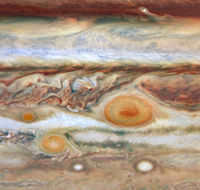
The mass of Jupiter is over twice the combined mass of all other planets in our solar system, 318 times the mass of Earth, and only 1000 times less than the mass of the Sun. If Jupiter were about 60 times more massive, it could have become a star. Jupiter has a density similar to that of the Sun but significantly less than that of Earth.
Due to the alignment of its equatorial plane with its orbit, Jupiter does not experience changes in seasons.
The upper atmosphere of Jupiter is mainly composed of clouds, making it difficult to observe anything else. Unlike planets with solid surfaces, Jupiter is primarily made up of gas.
Jupiter emits a significantly higher amount of energy compared to what it receives from the Sun. This phenomenon can be explained by various factors such as the planet’s gradual compression, the sinking of heavier elements and helium, or the presence of radioactive decay processes within its interior.
Many of the exoplanets discovered so far share similar mass and size characteristics with Jupiter, which is why the planet’s mass (MJ) and radius (RJ) are commonly used as reference units for specifying their parameters.
Composition of Jupiter
The composition of Jupiter primarily consists of hydrogen and helium. Beneath its thick clouds, there is a layer that extends 7-25 thousand kilometers deep. Within this layer, the hydrogen undergoes a state change from gas to liquid as pressure and temperature increase, reaching up to 6000 °C. Interestingly, there is no distinct boundary separating gaseous hydrogen from liquid hydrogen. This layer resembles a vast and continuous boiling global ocean of hydrogen.
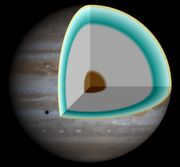
Jupiter’s internal structure can be represented by a model, which consists of a rocky core surrounded by a thick layer of metallic hydrogen.
The theoretical models suggest that beneath the layer of liquid hydrogen, there is a layer of liquid metallic hydrogen, with a thickness of approximately 30-50 thousand kilometers. The formation of this liquid metallic hydrogen occurs under immense pressures, reaching several million atmospheres. In this state, the protons and electrons are separated, allowing for efficient electrical conductivity. It is the powerful electric currents flowing within the metallic hydrogen layer that generate Jupiter’s enormous magnetic field.
Scientists hypothesize that Jupiter possesses a compact rocky nucleus composed of dense elements (heavier than helium). With a diameter ranging from 15,000 to 30,000 kilometers, the core exhibits a remarkable density. Based on theoretical calculations, the temperature at the core’s boundary is estimated to be approximately 30,000 K [1], while the pressure reaches 30-100 million atmospheres.
Measurements obtained both from Earth and space probes have unveiled that Jupiter emits a considerable amount of energy, predominantly in the form of infrared radiation, surpassing the energy it receives from the Sun by 1.5 times. This indicates that Jupiter retains a significant reservoir of thermal energy acquired during its formation through the compression of matter. It is widely accepted that the interior of Jupiter remains intensely hot, hovering around 30,000 K [1].
Composition of Jupiter’s Atmosphere
Jupiter’s atmosphere is composed mainly of hydrogen, accounting for 81% of the total number of atoms and 75% of the total mass. Helium makes up 18% of the atoms and 24% of the mass. Other substances in the atmosphere make up less than 1%. These include methane, water vapor, ammonia, and traces of organic compounds, ethane, hydrogen sulfide, neon, oxygen, phosphine, and sulfur. Additionally, the outer layers of the atmosphere contain frozen ammonia crystals.
The different heights of clouds in Jupiter’s atmosphere are characterized by distinct colors. The highest clouds are red, followed by white, brown, and finally bluish clouds in the lowest layer.
The temperature of the outer layer of clouds is approximately -130 °C, but it rises quickly as you go deeper. As reported by the Galileo lander, at a depth of 130 km, the temperature reaches +150 °C and the pressure is 24 atmospheres. The pressure at the upper boundary of the cloud layer is around 1 atm, which is equivalent to the surface of the Earth. “Galileo has identified areas of higher temperature near the equator. It appears that in these areas, the outer layer of clouds is thinner, allowing the warmer inner regions to be visible.”
The wind speeds on Jupiter can reach speeds of over 600 km/h. The circulation of the atmosphere is influenced by two primary factors. Firstly, Jupiter’s rotation is not uniform across the equatorial and polar regions, causing atmospheric structures to form bands that encircle the planet. Secondly, there is a circulation of temperature caused by heat being released from the planet’s interior. Unlike on Earth, where atmospheric circulation is driven by the difference in solar heating between the equatorial and polar regions, the impact of solar radiation on temperature circulation on Jupiter is negligible.
The movement of heat from within Jupiter to its surface is visible as light zones and dark belts. The light zones, where pressure is higher due to upward flows, contain clouds located at a higher altitude (about 20 km). The light coloring of these clouds is likely due to a higher concentration of bright-white ammonia crystals. On the other hand, the dark belts below are composed of red-brown ammonium hydrosulfide crystals and have higher temperatures. These belts represent areas of downward flow. The zones and belts have different velocities in the direction of Jupiter’s rotation. The circulation period varies slightly depending on latitude, resulting in stable zonal currents or winds that consistently blow parallel to the equator in one direction. The velocities in this global system can reach 50 to 150 m/s or even higher. At the boundaries between belts and zones, there is intense turbulence, leading to the formation of numerous vortex structures. The most well-known of these formations is the Great Red Spot, which has been visible on Jupiter’s surface for the past 300 years.
Lightning and auroras have been observed in Jupiter’s atmosphere, with a power that is three orders of magnitude greater than what is found on Earth. Additionally, the Great X-ray Spot, a source of pulsating X-ray radiation, has been detected by the Chandra orbiting telescope. The reasons behind this phenomenon are still unknown.
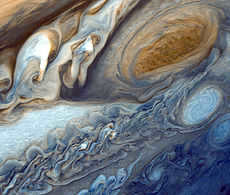
The Great Red Spot is a distinctive oval formation located in the southern tropical zone. Currently, it measures 15×30 thousand kilometers in size (which is significantly larger than the Earth), whereas a century ago, it was observed to be twice as large. On occasion, it may not be easily visible. The Great Red Spot is an extraordinary long-lasting giant hurricane (anticyclone) that rotates counterclockwise and completes a full revolution in six Earth days. It is characterized by upward atmospheric currents. The clouds within it are positioned at higher altitudes and have lower temperatures compared to the surrounding areas.
Magnetic Field and Magnetosphere
Jupiter possesses a powerful magnetic field, with the axis of its dipole inclined to its rotation axis by 10 degrees. The strength of the magnetic field at the visible cloud surface is 14 E at the north pole and 10.7 E at the south pole. Interestingly, the polarity of Jupiter’s magnetic field is opposite to that of Earth’s magnetic field.
The origin of this magnetic field can be attributed to the presence of metallic hydrogen within Jupiter’s interior. Metallic hydrogen, being an efficient conductor and rotating at high speeds, generates magnetic fields.
Jupiter possesses a strong magnetosphere, which stretches to a distance of 50-100 times its radius on the day side and extends beyond Saturn’s orbit on the night side. Electrons that are accelerated within Jupiter’s magnetosphere eventually reach Earth. If the Earth’s surface could observe Jupiter’s magnetosphere, its apparent size would surpass that of the Moon.
This magnetosphere is primarily formed by streams of charged particles that are carried by Jupiter’s magnetic field from the plasma torus located around the orbit of Io, one of Jupiter’s satellites. The primary source of these particles is the volcanoes on Io. Additionally, solar wind particles also contribute to the formation of Jupiter’s magnetosphere.
Jupiter possesses highly potent radiation belts. When Galileo approached Jupiter, he was exposed to a radiation dose 25 times greater than the lethal dose for humans. The discovery of radio emission from Jupiter’s radiation belt dates back to 1955. This radio emission is characterized by its synchrotron nature.
Enveloping Jupiter is a 3000 km long ionosphere.
Similar to the auroras observed on Earth, Jupiter’s auroras are a result of charged particles flowing along magnetic field lines into the atmosphere near the planet’s north and south poles. However, due to the vast size of Jupiter’s magnetic field, the presence of ionized matter expelled from the volcanic moon Io, which is captured by Jupiter’s magnetic field, generates auroras that are a thousand times more intense than those observed on Earth.
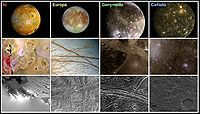
In December 2005, Jupiter had 63 known satellites, making it the largest number of satellites in the solar system. It is believed that there could potentially be up to a hundred satellites orbiting the gas giant. The four largest satellites, Io, Europa, Ganymede, and Callisto, were first discovered by Galileo Galilei in 1610. Out of these, Europa is particularly fascinating due to its global ocean, which raises the possibility of life existing within it. Io is also noteworthy for its active volcanoes. All of Jupiter’s major satellites are tidally locked, meaning they rotate in sync with their orbit around the planet and always present the same face towards Jupiter. The rest of the satellites are much smaller and have irregular shapes, resembling rocky bodies. Among them, there are a few that orbit in the opposite direction.
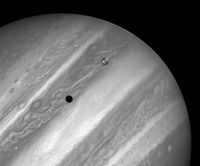
The rings of Jupiter were first discovered in 1979 during Voyager 1’s flyby of the planet. These rings are located 55,000 kilometers above the atmosphere and are oriented perpendicular to the equator. There are three rings in total, with two main rings and one inner ring that is extremely thin and has a distinct orange color. The thickness of the rings is estimated to be only a few kilometers. The rings are primarily composed of dust and small fragments, which do not reflect sunlight well, making them difficult to observe. However, they can be seen in the infrared spectrum from Earth. Studies conducted by the Galileo spacecraft have suggested that the rings are continuously replenished by small satellites orbiting Jupiter.
Name and history of study
In Babylonian culture, the planet was known as Mulubabbar, which translates to “star-sun.” Originally, the Greeks referred to it as Phaetontes – a term that means shining or brilliant – but later it was named Zeus. The Romans, on the other hand, decided to honor their god Jupiter by giving this planet his name.
In the early 17th century, Galileo Galilei utilized his self-invented telescope to observe Jupiter and made a groundbreaking discovery – he identified the planet’s four largest satellites. Fast forward to the 1660s, Giovanni Cassini observed peculiar spots and streaks on the surface of this colossal celestial body.
Exploration of Jupiter by Spacecraft
NASA spacecraft have been exclusively dedicated to the study of Jupiter.
In the years 1973 and 1974, Pioneer-10 and Pioneer-11 made close encounters with Jupiter at distances of 132,000 km and 43,000 km respectively, from the planet’s clouds. These spacecraft transmitted numerous images of low resolution of Jupiter and its moons, and also provided the first measurements of Jupiter’s magnetic field and magnetosphere.
In 1979, the Voyager spacecrafts made flybys of Jupiter at distances of 207,000 kilometers and 570,000 kilometers respectively.
For the very first time, a collection of high-resolution images of the planet and its satellites were successfully obtained (a grand total of approximately 33,000 photographs were transmitted). This groundbreaking mission led to the discovery of Jupiter’s magnificent rings. Moreover, the spacecraft transmitted a vast amount of other invaluable data, including comprehensive information regarding the chemical composition of the planet’s atmosphere, intricate details concerning its magnetosphere, and much more.
In the year 1992, Ulysses accomplished a momentous feat by soaring past the planet at an impressive distance of 900,000 kilometers. During this extraordinary encounter, the spacecraft diligently conducted a series of measurements specifically focused on Jupiter’s awe-inspiring magnetosphere (it is important to note that Ulysses is skillfully designed to meticulously study the Sun and therefore does not possess any cameras).
In the year 2000, Cassini had a flyby of Jupiter. It captured a series of photographs of the planet with an unprecedented level of detail and also gathered new information about Io’s plasma torus. The images taken by Cassini were used to create the most comprehensive and accurate color “maps” of Jupiter up until that point, with the ability to zoom in on details as small as 120 km. Additionally, an innovative experiment was carried out to simultaneously measure the planet’s magnetic field from two different vantage points – Cassini and Galileo.
On February 28, 2007, during its journey towards Pluto, the New Horizons spacecraft performed a gravitational maneuver near Jupiter. This allowed for the capturing of images of the planet and its moons, resulting in the transmission of a staggering 33 gigabytes of data back to Earth. This data has provided scientists with valuable new insights and information.
In the year 2010, there are plans in place to launch the Juno spacecraft. The aim of this mission is for Juno to enter into Jupiter’s orbit and conduct an extensive and detailed examination of the planet.
An expedition is being planned for the 2010s to explore the Galilean satellites in an interplanetary mission.
Exploring the Possibility of Life on Jupiter
Currently, it is considered unlikely that there is life on Jupiter due to the low amount of water in the atmosphere and the absence of a solid surface. However, in the 1970s, the American astronomer Carl Sagan suggested the possibility of ammonia-based life existing in the upper atmosphere of Jupiter [4]. It is important to note that even at relatively shallow depths in Jupiter’s atmosphere, the temperature and density are sufficiently high to allow for chemical evolution. This means that the possibility of at least chemical reactions taking place cannot be ruled out, as the conditions are favorable. Additionally, it is also possible that water-hydrocarbon based life could exist on Jupiter. In the layer of the atmosphere where water vapor clouds are present, the temperature and pressure are also very conducive for life.
Shoemaker-Levy Comet: A Unique Celestial Phenomenon
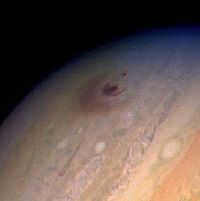
Interesting facts
- On July 19, 2009, an amateur astronomer named Anthony Wesley discovered a dark spot near the South Pole of Jupiter. This finding was later confirmed by the Keck Observatory in Hawaii[5][6].
Notes
- ↑ 12“Planetary Structure” – space.rin.ru
- ↑“Jupiter – New Horizons Photos”. – freescince.narod.ru
- ↑“Jupiter system in a new light from New Horizons” – freescince.narod.ru (14.05.2007)
- ↑“life on Jupiter” – daviddarling.info
- ↑Carolina MartinezNew NASA Images Indicate Object Hits Jupiter . Jet Propulsion Laboratory, Pasadena, Calif. Checked July 23, 2009.


